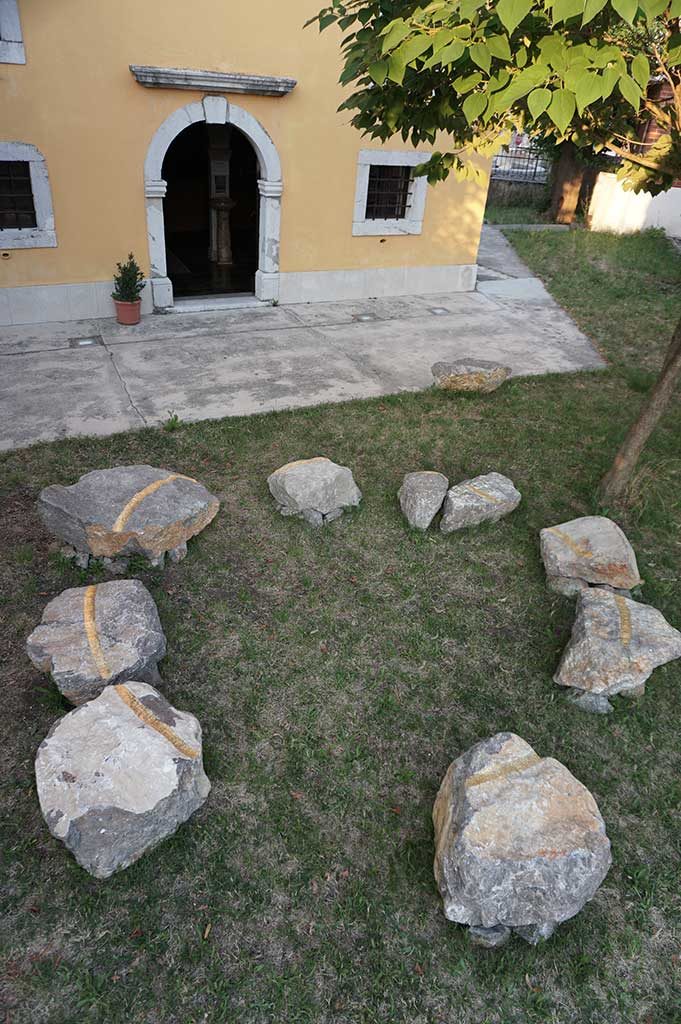„Wir / Me / We“
Die zehnteilige Skulptur “Wir / Mi / We” für Sveti Kuzam, einem Vorort von Rijeka in Kroatien, besteht aus zehn rohen Steinen aus einem nahegelegenem Steinbruch die für Mauern und Schotter verwendet werden. Die grauen, weißlichen und ockerfarbenen Steine sind mit unterschiedlichen Abständen zueinander vor dem Eingang der barocken Kirche “Sveti Kuzam i Damjan” auf einer Rasenfläche platziert. Jeder Stein wird unten von kleinen Steinen gehalten, wie auch die umlaufende Grenzmauer mit Ihrer Sitzbank. Die Steine der Skulptur, ihr Aufbau einschließlich der Höhen greifen somit ihre Umgebung auf. Wie ein Gegenpol wirkt die muldenförmige Kreislinie, die die Steine mit ihren individuellen Formen und Größen verbindet. Durch das Schneiden der Mulde (parallel zur Oberfläche) ist die “ausstrahlende” Struktur des Kreises entstanden, durch das Klopfen und Prellen mit dem Hammer zum Mittelpunkt ist die Kreisbewegung dazu gekommen. Die Kanten der zehn Steine sind poliert. Beim Polieren wird ihre Materie abgetragen und somit weniger. Gleichzeitig wird gerade dadurch ihre Grundform präsenter, besonders wenn sich das Sonnenlicht in den polierten Kanten reflektiert. Für das Auge wirken die Flächen weich und die Kanten hart, für den Tastsinn ist es umgekehrt. Die Maße der Abstände der Steine untereinander stammen aus der Fibonacci Reihe, einer unendlichen Zahlenfolge mit ganzen Zahlen. Selbst der zehnte Stein, der etwas außerhalb des Kreises steht, ist auf einer unsichtbaren Ebene mit allen anderen Steinen verbunden, er hat den selben Abstand zur Achse wie der Radius, 144 cm. Er steht noch auf der Rasenfläche und berührt schon die Betonfläche um die Kirche, wie eine andere neue Welt bildlich ausgedrückt.
Jeder Stein mit seiner eigenen Form steht für ein Individuum. Die sichtbare und zum Teil unsichtbare Kreislinie ist ein Bild einer Verbundenheit in einer Gemeinschaft.
So entsteht ein „Wir / Mi / We“
Stephan Goedecke, Sveti Kuzam 01.07.2017
„Wir / Me / We“
The ten-part sculpture We / Mi / We created for Sveti Kuzam, a suburb of Rijeka in Croatia, consists of ten rough stones from a nearby quarry which produces building stones and gravel. The grey, whitish, and ochre-coloured stones are placed at different distances from each other, on a lawn in front of the entrance to the baroque church of St. Kuzman and Damien. Each stone is held in place by small stones lined around its base, which echos the relationship between the perimeter wall and the bench leaning against it. The stones making up the sculpture, their composition and their heights, thus reflect their surroundings. The trough-shaped circular line which connects the stones, their individual shapes and sizes, has the opposite effect. The “radiating” form of the circle was cut in the stones parallel to the surface. A hammer was then used to knock out excess material and deepen the circular trough. The edges of the ten stones are polished. During the polishing process, material has been removed and the mass diminished. At the same time, this is exactly what makes the basic shape of the stones more present, especially when the sunlight is reflecting on their polished edges. To the eye, the surfaces look soft and the edges hard, to the touch, it is the other way around. The distances of among the stones are based on the Fibonacci series, an infinite sequence of whole numbers. Even the tenth stone, which is situated slightly out of the circle, is invisibly connected with all the other stones. Its distance from the axis is the same as the radius of the stone circle: 144 cm. The tenth stone stands on the edge of the lawn, already touching the concrete surface surrounding the church. Figuratively speaking, it is like another new world.
Every stone with its own shape represents an individual. The partly invisible circle represents the closeness and ties shared within a community.
This gives rise to We / Mi / We.
Stephan Goedecke, Sveti Kuzam, July 1st 2017








